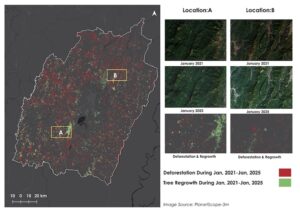 A large forest fire swept through Arunachal Pradesh’s Nadipar region near Dirang in West Kameng district on April 24, 2025, raising alarms over the growing vulnerability of the region’s fragile ecosystems. Strong winds fueled the blaze, which scorched several acres of forest land, though no human casualties or property losses were reported.
A large forest fire swept through Arunachal Pradesh’s Nadipar region near Dirang in West Kameng district on April 24, 2025, raising alarms over the growing vulnerability of the region’s fragile ecosystems. Strong winds fueled the blaze, which scorched several acres of forest land, though no human casualties or property losses were reported.
Satellite monitoring by Suhora Technologies, using daily PlanetScope imagery and machine learning, revealed that 1.09 square kilometers of forest cover were lost in the incident. As of April 26, 0.03 square kilometers remained under active fire. Such real-time data is proving vital in detecting and managing forest fires in remote northeastern regions where ground alerts are often delayed.
Krishanu Acharya, CEO of Suhora Technologies, highlighted the significance of satellite-driven intelligence for environmental management. “The deforestation numbers are worrisome, but there is potential for natural regrowth. What’s urgently needed are sustainable land-use plans and stronger community-based forest care,” he stated.
While the fire in Arunachal Pradesh grabbed attention, environmental concerns are also growing in neighboring Manipur. Infrastructure developments like road and railway projects, aimed at improving connectivity in this border state, have inadvertently triggered fresh deforestation. Clearing land for such projects weakens hill slopes, raising the risk of landslides, especially as changing rainfall patterns caused by climate change intensify these threats.
Experts warn that the double impact of human development and climatic shifts is making the northeastern forests more susceptible to wildfires, pest outbreaks, and habitat loss. Without urgent policy measures, these pressures could permanently damage the region’s rich biodiversity and the livelihoods of forest-dependent communities.
The recent findings underscore the critical need for integrated environmental policies that balance development with ecological preservation, ensuring that Northeast India’s forests remain resilient for future generations.
